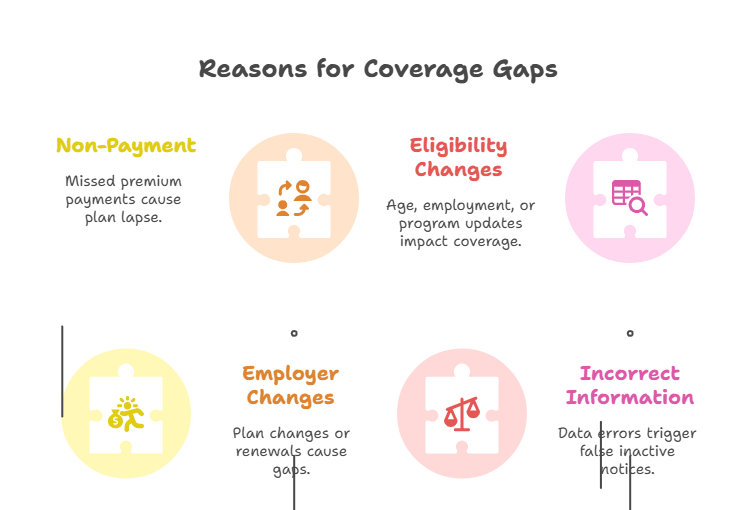On-Demand Outsourcing BPO Services for Healthcare Providers With 24/7 Coverage!
Save up to 70% on staffing costs!
Browse Specialty Staffing ServicesWhat Happens If Coverage Is Inactive at Time of Service?

It’s a busy Monday morning at Lakeside Family Clinic. A patient, Sarah, arrives for her scheduled appointment and hands over her insurance card. As the front-desk coordinator enters her details, a red flag appears: coverage inactive.
Sarah looks shocked. She insists she hasn’t changed her insurance, but the system shows her policy terminated last month. Now she faces an unexpected out-of-pocket payment—or a rescheduled visit.
This is a scenario clinics face daily, highlighting why verifying active coverage before services is crucial to avoid confusion, lost revenue, and patient dissatisfaction.
Why Coverage Status Matters
Active insurance coverage ensures that:
• Services are billed correctly and reimbursed
• Patients aren’t hit with unexpected costs
• Practices avoid delayed payments or write-offs
If coverage is inactive at the time of service, it typically means the insurer won’t pay the claim, leaving financial responsibility with the patient or the clinic.
What Causes Inactive Coverage?

Non-Payment of Premiums – The patient’s plan lapses due to missed payments.
Employer Plan Changes – Employer-sponsored plans change providers or renew policies, leading to temporary gaps.
Eligibility Changes – Age-based cutoffs, employment status changes, or Medicaid/Medicare updates can impact coverage.
Incorrect Information – Data entry errors or outdated patient records can trigger false inactive notices.
What Happens If Coverage Is Inactive?
When a patient’s coverage is inactive at the time of service:
• The claim is denied, resulting in no insurance reimbursement.
• The patient may be required to pay out-of-pocket.
• Appointments may be delayed or rescheduled until active coverage is confirmed.
• Clinics risk revenue loss if services are provided without pre-verification.
How to Handle Inactive Coverage Situations
Verify Early: Confirm coverage at least 48–72 hours before the appointment using eligibility tools or payer portals.
Communicate Clearly: Inform patients immediately if their coverage is inactive and provide guidance on next steps.
Offer Payment Options: Provide self-pay rates, payment plans, or rescheduling until coverage is reinstated.
Re-Verify Post-Update: Patients can often resolve lapses quickly with their insurer—recheck status promptly.
Document Thoroughly: Keep detailed notes of verification attempts, insurance communications, and patient interactions.
The Role of Virtual Insurance Verification Assistants
Virtual Insurance Verification Assistants (VIVAs) help clinics:
• Run pre-visit eligibility checks
• Contact payers to confirm status and resolve discrepancies
• Track coverage updates in real-time
• Reduce denied claims and administrative backlogs
Staffingly: Your Partner in Verification and Revenue Protection
At Staffingly, our Virtual Insurance Verification Assistants ensure:
• Coverage is confirmed well before visits
• Patients are notified early about inactive plans
• Claims are filed accurately, reducing denials and rework
• Front-office teams focus on patient experience rather than insurance calls
By proactively managing insurance verification, we protect your revenue cycle and prevent costly coverage surprises.
What Did We Learn?
Inactive Coverage Leads to Claim Denials: When insurance is inactive at the time of service, providers risk unpaid claims, leaving patients responsible for costs.
Common Causes of Inactive Coverage Include Plan Changes and Payment Lapses: Coverage often becomes inactive due to non-payment, employer plan updates, eligibility changes, or data errors.
Early Verification Prevents Revenue Loss: Confirming insurance status 48–72 hours before appointments reduces surprises, denials, and last-minute disruptions.
Clear Communication Improves Patient Trust: Informing patients promptly about inactive coverage allows them to resolve issues or prepare for self-pay options.
Documentation is Critical: Recording verification attempts, payer responses, and patient communications protects clinics from disputes and supports revenue integrity.
Virtual Support Streamlines the Process: Virtual Insurance Verification Assistants help clinics run proactive checks, manage payer calls, and keep coverage data accurate, reducing administrative burden.
Staffingly Offers End-to-End Verification Solutions: With HIPAA-compliant virtual verification experts, Staffingly minimizes claim denials and ensures financial stability for healthcare practices.
What people are asking?
1. What does inactive coverage mean?
Inactive coverage means a patient’s health insurance policy is not currently active, so the insurer will not pay for services rendered during that period.
2. Why would a patient’s coverage be inactive?
Common reasons include missed premium payments, employer plan changes, eligibility changes (e.g., job loss or age limits), or incorrect insurance information.
3. What happens if I provide care when coverage is inactive?
The claim will likely be denied, and the patient may be responsible for paying the full cost of services out-of-pocket unless alternative arrangements are made.
4. How can clinics prevent inactive coverage issues?
Clinics should run insurance verification checks 48–72 hours before appointments to confirm eligibility and notify patients if coverage problems arise.
5. Can inactive coverage be reinstated quickly?
Yes. Many insurers allow patients to reinstate coverage by paying missed premiums or updating eligibility information. Clinics should re-verify coverage once resolved.
6. How should staff handle patients with inactive coverage?
Staff should clearly explain the issue, offer options (self-pay rates, payment plans, or rescheduling), and assist patients in contacting their insurer to resolve the problem.
7. Does inactive coverage affect prior authorizations?
Yes. Any approved authorizations tied to an inactive policy may become invalid, requiring re-submission under an active policy.
Disclaimer
For informational purposes only; not applicable to specific situations.
For tailored support and professional services,
Please contact Staffingly, Inc. at (800) 489-5877
Email : support@staffingly.com.
About This Blog : This Blog is brought to you by Staffingly, Inc., a trusted name in healthcare outsourcing. The team of skilled healthcare specialists and content creators is dedicated to improving the quality and efficiency of healthcare services. The team passionate about sharing knowledge through insightful articles, blogs, and other educational resources.
 Book a Demo to Build Your Team Today!
Book a Demo to Build Your Team Today!

 Read Case Studies
Read Case Studies 


 Virtual Medical Assistants
Virtual Medical Assistants



